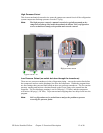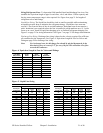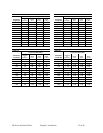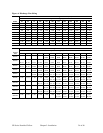GP Series Portable Chillers Chapter 3: Installation 20 of 90
Remote Air-Cooled Chiller Condensers
Remote air-cooled portable chillers are shipped with nitrogen holding charge and a full
charge of oil (excluding the amount needed for field piping). The remote air condenser is
shipped with a dry nitrogen charge. Verify that the holding charge has not been lost prior to
installation. If there is no pressure, leak test the unit and repair before installing the
interconnecting refrigerant piping. Read this entire section before installation.
Note: Piping should be hard/drawn type “L” or type “K” refrigerant grade copper
tubing only. Proper sizing and installation has a significant effect on system
performance, reliability, and safety.
Warning! The copper tubing and fittings used must have a minimum burst
pressure of 1,950 psi.
Interconnecting Refrigerant Piping. The chiller and condenser refrigerant lines are
terminated with a cap and brazed closed. Use a tube cutter to remove caps.
Caution! Do not use a saw to remove the end caps because this will allow copper chips to
contaminate the system.
A certified refrigeration contractor needs only to install the interconnecting refrigerant piping
between the chiller and the outdoor air-cooled condenser. This piping must be properly sized,
type “L” or type “K” refrigerant grade tubing, high temperature brazed. Install a customer
supplied 650 psi approved refrigerant relief valve in the discharge line at the condenser,
following all applicable codes.
Flow dry nitrogen through the system when brazing copper joints to prevent carbon/scale
formation; which causes contamination. Isolate the refrigerant lines from the building,
preventing transfer of line vibration to the structure. Do not secure the lines rigidly.
Leak check and evacuate the system down to 400 microns. A decay of 50 microns after one
hour is acceptable.
Warning! To prevent injury or death due to explosion and/or inhalation of hydrogen-
fluoride gas, purge system thoroughly while brazing refrigerant piping
connections. Use a pressure regulator in the line between the unit and the
high-pressure nitrogen cylinder to avoid over-pressurization and possible
explosion.
System Configuration. The system can be configured in any of the arrangements shown on
page 75 of the Appendix. The configuration and distance between the chiller and the
condenser affects pipe size, refrigerant charge, oil return, and oil charge. Therefore there are
limitations that must be adhered to for reliable and optimal operation.
Leaving water temperature affects discharge line size. Be sure to inform the installing
contractor of the leaving water temperature range in which the chiller will be operating
The total distance between the chiller and condenser must not exceed 200 feet or 300
equivalent pipe feet
Discharge line risers cannot exceed an elevation difference greater than 100 feet
without a 2% efficiency decrease.
Refer to page 75 of the Appendix for the location of traps.
Refrigeration lines must not be crossed, i.e., chiller liquid lines are to be piped to
condenser liquid lines.


















